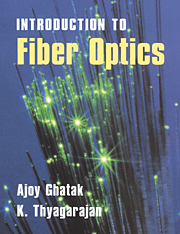Book contents
- Frontmatter
- Contents
- Preface
- Acknowledgments
- Abbreviations
- 1 Introduction: The fiber optics revolution
- 2 Basic optics
- 3 Basic characteristics of the optical fiber
- 4 Ray paths and pulse dispersion in planar optical waveguides
- 5 Pulse dispersion in graded index optical fibers
- 6 Material dispersion
- 7 Modes in planar waveguides
- 8 Propagation characteristics of a step index fiber
- 9 Propagation characteristics of graded index fibers
- 10 Waveguide dispersion and design considerations
- 11 Sources for optical fiber communication
- 12 Detectors for optical fiber communication
- 13 Design considerations of a fiber optic communication system
- 14 Optical fiber amplifiers
- 15 Dispersion compensation and chirping phenomenon
- 16 Optical solitons
- 17 Single-mode fiber optic components
- 18 Single-mode optical fiber sensors
- 19 Measurement methods in optical fibers: I
- 20 Measurement methods in optical fibers: II
- 21 Periodic interactions in waveguides
- 22 The ray equation in cartesian coordinates and its solutions
- 23 Ray paths and their classification in optical fibers
- 24 Leaky modes
- Appendix A Solution of the scalar wave equation for an infinite square law medium
- Appendix B The far-field pattern
- Appendix C WKB analysis of multimode fibers
- Appendix D Gaussian envelope approximation
- Appendix E Coupled-mode equations
- Appendix F Derivation of coupled-mode equation for periodic coupling
- Appendix G Leakage loss in optical waveguides
- References
- Index
14 - Optical fiber amplifiers
Published online by Cambridge University Press: 05 June 2012
- Frontmatter
- Contents
- Preface
- Acknowledgments
- Abbreviations
- 1 Introduction: The fiber optics revolution
- 2 Basic optics
- 3 Basic characteristics of the optical fiber
- 4 Ray paths and pulse dispersion in planar optical waveguides
- 5 Pulse dispersion in graded index optical fibers
- 6 Material dispersion
- 7 Modes in planar waveguides
- 8 Propagation characteristics of a step index fiber
- 9 Propagation characteristics of graded index fibers
- 10 Waveguide dispersion and design considerations
- 11 Sources for optical fiber communication
- 12 Detectors for optical fiber communication
- 13 Design considerations of a fiber optic communication system
- 14 Optical fiber amplifiers
- 15 Dispersion compensation and chirping phenomenon
- 16 Optical solitons
- 17 Single-mode fiber optic components
- 18 Single-mode optical fiber sensors
- 19 Measurement methods in optical fibers: I
- 20 Measurement methods in optical fibers: II
- 21 Periodic interactions in waveguides
- 22 The ray equation in cartesian coordinates and its solutions
- 23 Ray paths and their classification in optical fibers
- 24 Leaky modes
- Appendix A Solution of the scalar wave equation for an infinite square law medium
- Appendix B The far-field pattern
- Appendix C WKB analysis of multimode fibers
- Appendix D Gaussian envelope approximation
- Appendix E Coupled-mode equations
- Appendix F Derivation of coupled-mode equation for periodic coupling
- Appendix G Leakage loss in optical waveguides
- References
- Index
Summary
Introduction
As discussed earlier, optical fiber communication systems are ultimately limited by either loss or dispersion. Loss leads to power levels of received signal that cannot be detected within tolerable errors, whereas dispersion leads to overlapping of adjacent pulses of light with resultant loss in resolution and, hence, information. Figure 14.1 shows a typical wavelength dependence of loss and dispersion of a single-mode fiber for both a CSF with zero dispersion around 1300 nm and a DSF with zero dispersion around 1550 nm. As evident from the figure, the effect of loss can be minimized by operating at the minimum loss wavelength around 1550 nm, whereas dispersion can be minimized by operating at the zero dispersion wavelength. Using DSFs has advantages of both minimum loss and zero dispersion. Figure 14.2 shows the maximum permissible unrepeatered length as a function of bit rate as determined by loss or by dispersion for both a CSF and a DSF (see Chapter 13 for a detailed discussion of this figure). The pulses are assumed to be Fourier transform limited. As can be seen from the figure, even at bit rates of 2.5 Gb/s, a system operating with CSFs is limited by loss rather than by dispersion. For DSF, loss-limited operation extends to almost 10 Gb/s.
In long-haul fiber optic communication systems, the effects of loss and pulse dispersion are normally overcome by using periodically spaced electronic repeaters. In these repeaters the input optical signal is first detected and converted to electrical signals.
- Type
- Chapter
- Information
- An Introduction to Fiber Optics , pp. 281 - 322Publisher: Cambridge University PressPrint publication year: 1998
- 2
- Cited by



